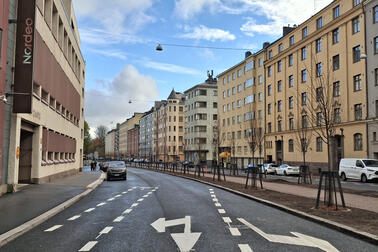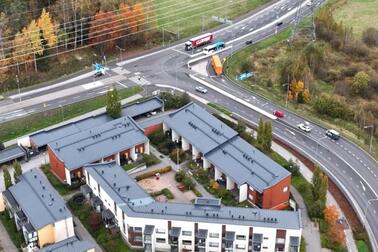
The City of Helsinki has reviewed its street network to identify any pedestrian crossings that are classified as dangerous. There are still several dozen of these in the city centre. The aim is to get rid of all dangerous crossings, such as non-light-controlled crossings across several unidirectional lanes, in the next few years.
Examples of safety improvements on the dangerous crossings include speed bumps, narrowed sections and traffic lights, as well as converting the crossings into unmarked crossing points or removing the crossing option altogether. The choice of a suitable method is decided based on factors such as the street crossing needs, the distance to other crossings and the characteristics of the street.
Unmarked crossings have no pedestrian crossing signs or road markings.
A second pedestrian crossing was removed from the Kaupunginpuutarha tram stop on Helsinginkatu, and this point was converted into an unmarked crossing. A traffic light-controlled crossing can be found at the other end of this low-traffic tram stop, by Mäntymäentie. This is the primary and accessible route to the stop and across the street.
An unmarked crossing has no pedestrian crossing signs or painted stripes on the street, but they allow the street to be crossed as long as pedestrians give the right of way to cars, trams and bicycles. Temporary road signs have been put in place to inform pedestrians of the new rules on giving way.
“An unmarked crossing can be identified by the absence of all pedestrian crossing signs or painted stripes on the street. The pedestrian is obliged to give way at these points. When stepping onto the driving lane, pedestrians must judge the distance and speed of the approaching vehicle. If a pedestrian estimates that they can cross the lane, they must do so without undue delay. Drivers, on the other hand, should refrain from allowing pedestrians waiting on the pavements to cross the street out of courtesy, as this can lead to rear-end collisions,” says traffic engineer Aleksi Kinnunen.
The pedestrian crossing was converted into an unmarked crossing, as it did not comply with the Finnish Road Traffic Act. The removed crosswalk was dangerous because it was at a bend in a busy street and had poor visibility and no traffic lights. The location was a prime spot for a so-called guillotine effect, where a pedestrian using the crossing is in danger when only a driver on one of the lanes stops their car at a pedestrian crossing.
However, the crossing was not blocked completely, as the new arrangements will bring its safety to a satisfactory level. The arrangement can provide a viable shortcut to the stop from the Kallio direction, especially during off-peak hours.
Unmarked crossing points often have a pedestrian crossing nearby.
An unmarked crossing point without a pedestrian crossing is used when it is difficult to provide a safe crossing or when it is not reasonable, for example, because of traffic volumes. Traffic on main streets is often so heavy that it is not possible to make a pedestrian crossing usable without traffic lights.
However, neither should pedestrian crossings be built in places with a low number of pedestrians crossing the street, as this could lead to drivers passing the crossings getting used to not needing to be prepared to allow someone to cross. The pedestrian crossing removed from the Kaupunginpuutarha tram stop had a low number of users.
Therefore, converting little-used pedestrian crossings into unmarked crossings will improve crossing safety on a wider scale, as these are only used in situations where a driver can expect to have to give way to a pedestrian. On the main traffic network, crossing the street is primarily done at intersections, where there are more people crossing the street and it is easier to arrange a safe crossing.
A common practice in Europe to be brought to Helsinki
In Helsinki, there are a few similar unmarked crossings, e.g. on Sturenkatu at the western end of the tram stop.
Similar crossings are also planned for Mannerheimintie, Tukholmankatu and Hämeentie. Under prior principles, crossing in similar locations would have been completely prevented by fencing or other structures.
The changes are based on the design principles for pedestrian crossings approved by the Urban Environment Committee on 10 December 2019 and the traffic safety improvement programme approved by the City Board on 7 March 2022.
- Helsinki Traffic Safety Development Programme 2022–2026 (in Finnish)(Link leads to external service)
- Design Principles for Pedestrian Street Crossing Arrangements (in Finnish)(Link leads to external service)
- Decision: Traffic Arrangements, Tram Stop, City Garden (in Finnish)(Link leads to external service)


